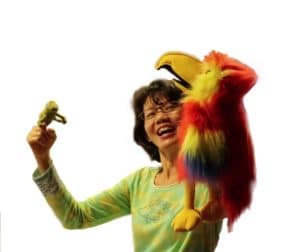Bedtime stories, travel tales, folk and fairy tales, myths and legends – many stories, shared all the time. Telling a story is passing wisdom, sharing cultures, moments and creating a bond. 3 Professional Storytellers of Storytelling Association of Singapore help decode ‘storytelling’ by sharing their memorable moments of telling their favourite stories.
Storytelling Association was founded in 2006, at a time when modernised Singapore was beginning to recover the ancient art of oral storytelling. The association promotes the practice and appreciation of oral storytelling at homes, in schools, in the community and at work. Together with the nation’s Book Council and Library Board, Storytelling Association (Singapore) helps to organise festivals and congresses where well-known overseas storytellers share the skills and techniques of oral storytelling. Many of its members today tell stories to children, teenagers and adults and promote storytelling in the region.
Wong Swee Yean

Swee Yean is the current President of Storytelling Association (Singapore). She has been telling stories for 15 years. Swee Yean has performed commissioned works for Singapore heritage programmes in museums and has provided customised workshops for schools, teachers and organizations. Recently, she worked with senior citizens to preserve the oral heritage of the Chinese community. She believes that the oral tradition has a very important place in society. While it preserves identity, it glues the whole society together.
The Teller – Swee Yean
I was a school teacher. To entertain my students, I told stories at the start of the class. My students would look forward to this daily dose of stories. I too, enjoyed telling them. Gradually, I moved on to telling stories professionally. When I tell stories, I like to create a warm and comfortable atmosphere through songs and active audience interaction. I think stories stir up the moral imagination and creating gentle positive change in the audience. Here is one of my favorite stories to tell children.
I stumbled upon this story when I was looking for stories from the ASEAN countries. The story touched my heart when I first read it because it is a folklore of a society not as modern as the one I grow up in. In fact, Laos is one of East Asia’s poorest country. The story is about an underdog character who lives in a society that is inclusive and celebrates diversity. I am reminded that before Singapore became a modernised and materialistic society, we used to be community-spirited and that we should not forget that part of ourselves.
The Tale – Thao Kham The Pebble Shooter
Thao Kham The Pebble Shooter is a tale from Laos. t is about an orphan, disabled boy who cannot walk. But his community cares for him. By chance, he learns to aim pebbles and discovers he can aim them well. He is clever and with diligent practice, he becomes a skilful pebble shooter in the village. He also crafts pictures of animals on huge leaves that one day impresses the king who is passing by the village. The king invites Thao Kham to the palace to assist him to play a trick on his most talkative advisors.
The Telling
There are a few different versions of this story. My version celebrates Thao Kham’s spirit and his quest to be independent and not wallow in self-pity.
When I tell the story, I play up the part where Thao Kham tosses mud pebbles into the advisor’s mouth. I describe how the little balls fly in his mouth without his realizing it, rendering him speechless. The mud balls fly swiftly and with precision that the advisor cannot fathom what has flown into his mouth. I describe this scene with multi-sensory images. Children enjoy this scene a lot. I have even seen some children in the audience open and close their mouths, and then swallow the mud balls as if they were the talkative advisor enduring that unpleasant moment. After that, they laugh about the advisor’s embarrassment. It delights me to see my audience get entertained and at the same time get educated about the disabled.
This story also allows a glimpse into a lesser known country. So at times, I tell the story and talk about Laos. It is ironic that Laos was severely bombed from 1964 to 1973 and that many unexploded bombs left behind have maimed the local people and children.
I hope that when children listen to the story of Thao Kham and get entertained, somewhere in their subconscious, they will become more inclusive and more appreciative of the disabled people around us.
Karen Lee
Karen has told stories to various age groups ranging from 4 to 60 and beyond. She tells stories to different audiences at libraries, schools and community events, catering her stories to her audience needs. She has told stories at local and International festivals. Karen also conducts storytelling workshops for preschool teachers, parents, adults and students eager to use storytelling in various ways such as: storytelling in education, parent-child bonding, incorporating stories for heritage trail guides or tour guides, or to enhance oral communication skills.
The Teller – Karen
I was teaching children with learning difficulties and conducting reading programmes for children who struggled with reading in English. Back then, I would read stories to them out of a book. It was at a Storytelling Workshop that I discovered Oral Storytelling. That opened up a whole new world of storytelling. I discovered that the children were more engaged in listening to stories told and they could enjoy the stories, without struggling with reading text. That was the start of my amazing storytelling journey. From there, I moved on to telling stories for different occasions and audiences.
My favourite story is a Jewish folktale about a Tailor. I first heard the story told at the Asian Storytelling Congress in Singapore by Bobby Norfolk. Later, I came across the story again in Hiroko Fujita’s book ‘Stories to Play With’. I liked the message behind the story about being thrifty and not being wasteful. On a personal level, this story appeals to me because my grandfather was a tailor. My grandmother made a blanket out of fabric samples. That blanket itself is a story about being thrifty and creative with limited resources. It is also a story about the love of a grandmother for her grandchild. I love telling this story because I can weave the Jewish folktale together with a personal story about love and resilience.
The Tale – Tailor
The story is about a tailor who, when given a piece of cloth by a grateful customer, makes a coat for himself from it and wears that coat proudly everywhere. But the coat soon gets worn out. The tailor, then makes a jacket out of the coat and wears it proudly everywhere. But the jacket too wears out. Then the tailor makes a vest out of that jacket, and then a cap out of the vest and then a button from the cap. He wears the button proudly everywhere. But soon the button wears out too. The tailor takes one look at the button and with not much left to make, tells a story about it. He proudly told his story everywhere. And because it was a story, it was never worn out and is still proudly told everywhere.
The Telling
This story has many layers and works on multiple levels with various audience. The repetition in the story appeals to young children, and the message of being creative and resourceful is clearly understood. On another level, this story is about STORY. Stories have a longevity beyond ourselves. Once told, the story stays in the mind of the listener. That story cajoles the listener to tell it and the listener becomes the storyteller.
I have told this story in English and Mandarin. One of the memorable moments of this storytelling was when I told this story in Mandarin to a group of children of mixed-age groups and ethnicity, and not everyone understood Chinese. However, the children gamely stayed to listen and happily joined in the storytelling, repeating the words and actions.
I was impressed by the children’s ability to understand a story despite the language barrier.
Stories can transcend language and age. Stories can be understood and enjoyed simply because it appeals to us as humans.
Kala Sundaraman
Kala is a professional storyteller and coach. She has been telling stories for the past
Kala believes that Storytelling is an integral part of public speaking and she reinforces that, facts tell but stories sell, as they play to the emotions of the audience and makes them act. Kala has been telling stories at Northlight School for the past five years and other forums in Singapore.
The Teller – Kala
Love for stories has been ingrained in me from a very young age. My father always drove home the message and importance of things in the form of parables, stories and anecdotes that he passionately related to me. Narrated playfully in the form of stories those lessons have stayed with me and helped me along the way in my interactions in my daily life. I believe in the power of stories to transform lives. “Many stories matter. Stories have been used to dispossess and to malign. But stories can also be used to empower, and to humanize. Stories can break the dignity of a people. But stories can also repair that broken dignity.” This quote by Chimamanda Ngozi Adichie aptly sums up my feelings.
My parents taught me to respect food. We had a zero-waste policy at home. I clearly recall an instance when I didn’t like what was on my plate and merrily binned it, only to get caught and then had to forego my next meal!
The African folktale, ‘Why the Sky Is Far Away” thus resonates with me. It depicts how we take nature’s bounty and munificence for granted to feed our insatiable gluttony and refuse to learn from repeated indiscretions. It is also a timely reminder to develop an attitude of gratitude towards Mother Nature!
The Tale – Why The Sky Is Far Away
In the beginning of time, the sky was close to Earth and what’s more, it was edible too! People always had enough to eat, without ever having to work for it. However people grew careless with the sky’s gifts and they didn’t care. They began wasting the sky. The sky cared and soon the sky’s sorrow turned to resentment and then to anger. The sky warned the people of the Earth to be mindful but to no avail! The sky, tired of man’s inconsiderate ways lifted itself up far, far beyond the reach of man! This taught man to respect Mother Earth.
The Telling
“What are the bounties of the sky?” I ask. ‘Rain, Sun, Moon, Stars’, shout out the kids in the audience. We then make actions for sun, moon, stars and create rain with snapping, clapping, tapping sounds. I then tell them that a very long time ago not only was the sky edible, but that it was so close to us that we could stretch out, reach up, tear a piece of sky and eat it. On hearing this their eyes grow big and wide in wonderment and disbelief! Some of them ask if someone as small as them can reach the sky? I then tell them, perhaps not you , but if you climbed by Bukit Timah Hill, (being the highest peak in Singapore) and stretch your hands out you may be able to grab a piece of the sky! When I come to the part where the village is having a feast in honour of the chief of the village with music and dance and food, I give them different small handheld noise-making devices to create music.
I have told this story to adult audience and to children. On hearing the story, adults feel a sense of gratitude and realize how we always believe that Mother Earth is so vast and will always be able to provide for our needs.

